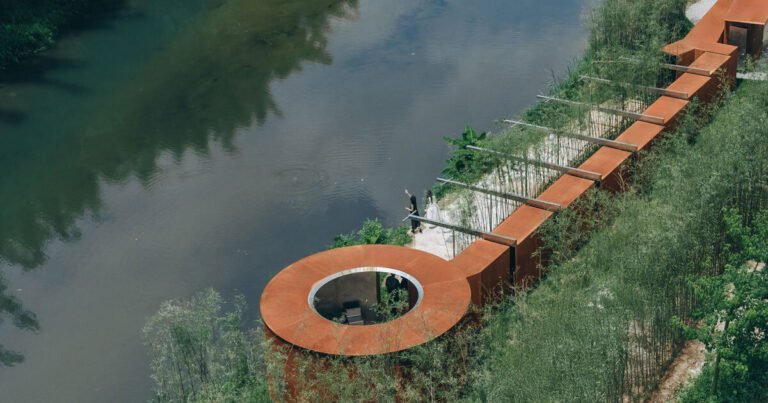
Contents
Rhythmic Steel Pavilion by DL Atelier Weaves Through Riverfront Bamboo Grove in China
The Floral Wander Loop, designed by DL Atelier, is a captivating elongated loop pavilion located in a bamboo grove between a road and the Tiegang River in Longtan Town, Huizhou, Guangdong Province, China. This innovative structure forms part of the Nankunshan–Luofushan Rim Pioneer Zone Architectural Art Project, which draws inspiration from Su Shi’s ‘Sixteen Joys of Life in Huizhou.’ The pavilion reinterprets the poetic metaphor ‘Humbly sought to make flowers bloom’ through spatial experience, offering a unique and immersive journey for visitors.
The Floral Wander Loop is a remarkable example of modern architecture that seamlessly integrates literary reference, environmental response, and spatial rhythm. Located in a stunning bamboo grove, the pavilion is organized as an elongated loop that aligns with both the flow of the Tiegang River and the movement of vehicles along the adjacent road. The circulation departs and returns along the same route, alternating between constricted and open spaces to generate a rhythmic sequence of compression and release. This clever design mediates between two linear continuities, the road and the river, by establishing a third layer within the bamboo grove. The pavilion serves as a spatial interface rather than a barrier, allowing natural drainage and vegetation to remain uninterrupted.
Design and Structure
The main structure of the pavilion consists of narrow weathering steel modules measuring approximately 2.1 meters high and 1.2 meters wide, arranged in a staggered parallel configuration to form a passageway. The units are elevated slightly above the ground on 1-centimeter steel plates, ensuring water permeability and preserving the site’s natural contours. This thoughtful design not only minimizes the impact on the environment but also creates a sense of harmony between the built form and the surrounding landscape.
Four Spatial Narratives
The pavilion unfolds through four spatial episodes, each reflecting a different stage in Su Shi’s life and poetic expression. These episodes are:
* Pleasant: The entrance plaza follows the site’s natural topography, opening at a higher elevation. Defined by gravel paving, bamboo edges, and minimal seating, it includes facilities such as a water bar and restrooms.
* Powerless: Within the corridor of weathering steel, visitors encounter a constricted, dimly lit environment. Here, environmental elements, light, wind, and rain, are perceived through narrow apertures, producing a heightened awareness of natural phenomena and spatial tension.
* Serendipitous: The path concludes in a circular pavilion containing a floral installation by artist Chen Zhuo. Inspired by natural rock formations, the work is rendered in stainless steel with a random hairline finish that diffuses color and light.
* Expansive: The loop extends outward toward the river, where swings made of metal mesh are positioned along the water’s edge. The open landscape, natural light, and reflective surfaces provide a contrast to the preceding enclosure.
These four spatial narratives work together to create a rich and immersive experience for visitors, inviting them to reflect on the themes of transformation and continuity that underlie Su Shi’s poetic works.
Integration of Literary Reference and Environmental Response
Through the Floral Wander Loop, DL Atelier has successfully integrated literary reference, environmental response, and spatial rhythm into a coherent architectural system. The project translates Su Shi’s reflections on transformation and continuity into built form, using minimal materials and topographical sensitivity. The pavilion establishes a dialogue between historical narrative and contemporary architectural language, demonstrating a deep understanding of the complex relationships between literature, architecture, and the environment.
Key highlights of the project include:
* The use of weathering steel modules to create a sense of harmony between the built form and the surrounding landscape
* The incorporation of natural elements, such as light, wind, and rain, into the design
* The creation of a rhythmic sequence of compression and release through the alternating constricted and open spaces
* The use of minimal materials and topographical sensitivity to minimize the impact on the environment
According to the architects, “The Floral Wander Loop is a spatial interpretation of Su Shi’s poetic metaphor, offering a unique and immersive journey for visitors. The pavilion serves as a spatial interface between the road and the river, establishing a third layer within the bamboo grove.”
Conclusion
The Floral Wander Loop is a remarkable example of modern architecture that seamlessly integrates literary reference, environmental response, and spatial rhythm. Through its innovative design and thoughtful approach to the environment, the pavilion offers a unique and immersive experience for visitors, inviting them to reflect on the themes of transformation and continuity that underlie Su Shi’s poetic works.
Conclusion: The Floral Wander Loop is a must-visit destination for anyone interested in architecture, literature, and the environment. This innovative pavilion is a testament to the power of design to create immersive and thought-provoking experiences that inspire and delight.
Keywords:
* Rhythmic Steel Pavilion
* DL Atelier
* Bamboo Grove
* Tiegang River
* China
* Literary Reference
* Environmental Response
* Spatial Rhythm
* Modern Architecture
* Sustainable Design
* Weathering Steel
* Natural Elements
* Immersive Experience
Hashtags:
* #RhythmicSteelPavilion
* #DLAtelier
* #BambooGrove
* #TiegangRiver
* #China
* #LiteraryReference
* #EnvironmentalResponse
* #SpatialRhythm
* #ModernArchitecture
* #SustainableDesign
* #WeatheringSteel
* #NaturalElements
* #ImmersiveExperience
Source link